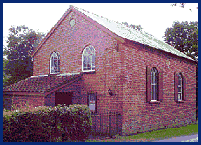
Church and chapel 4
A church divided
Political awareness
As the eighteenth century progressed the changes in farming and
landscape use, particularly the enclosure of common land, and
the new opportunities offered by the developing industrial centres,
added to the sense of turmoil in Wales. There was also a growing
political awareness among the newly literate sections of the
working classes. This led to the establishment of a small minority
of Arminians and Unitarians, who, unlike the revivalists, believed
that man and his powers of reason had a role to play in salvation.
At a time when America and France had challenged the old order
this was seen as threat and even the relatively reactionary methodists
suffered persecution. This led to congregations leaving the Church
of England and seeking the protection of the Toleration Act.
Increased influence of methodism
The period 1790 to 1810 was one of consolidation for Welsh methodism,
with the movement being strengthened by the spread of sunday
schools. Many congregations began to elect their own elders,
and the movement away from the established church seemed inevitable
to many.
In 1811 the Calvinistic Methodist denomination was founded and,
although local congregations probably did not yet see it that
way, Welsh methodism had joined the ranks of nonconformity. Although
Wesley had not sought Welsh recruits his preaching tours to the
principality did have an influence. Wesley an
groups were established with leaders like Thomas Coke of Brecon
being active in creating a Welsh Mission.
an
groups were established with leaders like Thomas Coke of Brecon
being active in creating a Welsh Mission.
The chapel pictured (right) near Betws Cedewain dates
from 1795. The Wesleyan Conference was highly centralised, however,
and even Welsh language congregations were part of an English
based structure.
Massive expansion
The first half of the nineteenth century was a period of massive
expansion for all nonconformist sects in Wales, with the equivalent
of one chapel being built every eight days. Itinerant preachers
were able to stir up enthusiasm, particularly in the new industrial
areas where the old parish system meant that the Church of England
was slow to respond to the needs of the new population centres.
Here local people took up the challenge of creating their own
places of worship where ordinary member of the congregation had
a genuine sense of involvement, and which were the focus for
a great range of other activities.
There are 8 pages in this sequence. Use the box links below to view the other pages.